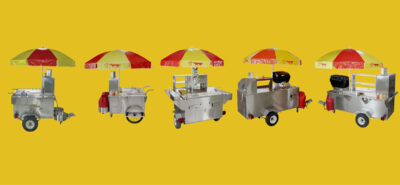The History of The Hot Dog
If you are considering getting into business as a hot dog cart vendor, it may be a good idea to do some research on the hot dog’s history! Although we often think of the hot dog as an American staple food, it did not actually originate here. Read on for a bit of history of the hot dog!
The hot dog (also spelled hotdog) is a grilled or steamed link-sausage sandwich where the sausage is served in a sliced bun. It can also refer to the sausage itself. The sausage used is the wiener (Vienna sausage) or frankfurter (also frank). The names of these sausages also commonly refer to their assembled sandwiches. Hot dog preparation and condiments vary regionally in the US. Typical condiments include mustard, ketchup, mayonnaise, relish, and cheese sauce. Common garnishes include onions, sauerkraut, jalapeños, chili, grated cheese, coleslaw, and olives. Hot dog variants include the corn dog and pigs in a blanket. The hot dog’s cultural traditions include Nathan’s Hot Dog Eating Contest and the Oscar Mayer Wienermobile. We talk about Nathan’s Hot Dog Eating Contest in a different blog.
These types of sausages and their sandwiches were culturally imported from Germany and became popular in the United States. At the time the “hot dog” became a working-class street food sold at stands and carts. Eventually, the hot dog became closely associated with baseball and American culture. Although particularly connected with New York City and its cuisine, the hot dog became ubiquitous throughout the US during the 20th century, and emerged as an important part of other regional cuisines, including Chicago street cuisine.
It’s fun and interesting to learn about the story behind hot dogs. Understanding how other cultures dress up their hot dogs gives you more expertise in your business! It can even give you inspiration for your own hot dog cart menu and allow you to experiment with unique topping combinations.













LEAVE A COMMENT